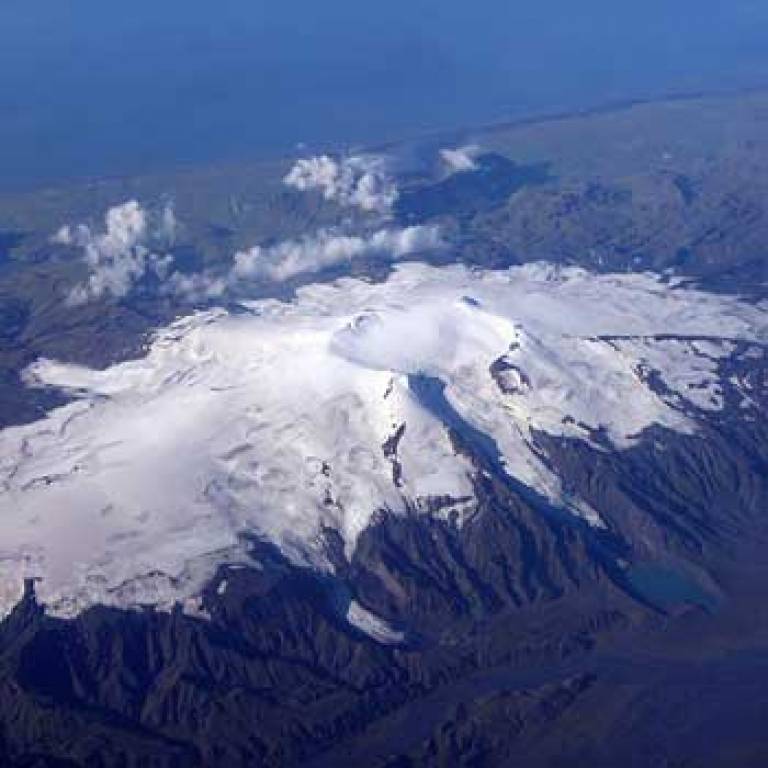Under the volcano: The Eyjafjöll eruption
15 April 2010
Links:
 abuhrc.org/Pages/index.aspx" target="_self">Aon Benfield UCL Hazard Research Centre
abuhrc.org/Pages/index.aspx" target="_self">Aon Benfield UCL Hazard Research Centre
Bill McGuire in the Guardian
Professor Bill McGuire (Aon Benfield UCL Hazard Research Centre) discusses the eruption of the Eyjafjöll volcano in Iceland, which has sent a huge cloud of ash toward the UK and disrupted air traffic.
"The 1600m high Eyjafjöll volcano (also known as Eyjafjallajökull) is located in southern Iceland, immediately west of Katla volcano. Eyjafjöll is an elongated, ice-covered volcano topped by a 2.5km-wide summit caldera. The volcano appears to have been relatively inactive over the last 10,000 years, and the sole historical eruption, prior to this year, occurred in 1821.
"The current eruption started on 20 March 2010. Following a pause in activity, a new vent opened on 13 April generating a column of ash several kilometres high and causing melting of overlying glacier ice. This resulted in the formation of glacial outburst floods that closed roads and caused some structural damage. 700 people were evacuated from the area as a precaution.
"The ash cloud generated by the ongoing eruption is currently to the north of Scotland, and heading south at a height of about 18km. As predicted the cloud has moved across Scotland and spread to England, closing airports across the country.
"Volcanic ash is silica-based material and highly abrasive. It is capable of causing major damage to aircraft through clogging engines and causing them to flame out, and by scouring windscreens so as to make them opaque.
"Over the past few decades there have been more than 80 encounters between civil aircraft and ash clouds, resulting in a number of situations wherein crashes have only narrowly been avoided.
"Most notable was an encounter in 1982 between a BA 747 and an ash cloud from Galunggung volcano in Indonesia. Ash in the engines resulted in all four failing, causing the plane to fall 7,000m before the engines could be restarted. Even then, landing was made extremely difficult by the fact that the windscreen had been scoured opaque by the ash.
"It is not particularly unusual for ash from Icelandic eruptions to reach the UK. The most notable occasion occurred in 1783, when a cloud of ash and sulphurous gases from the major Laki eruption lay across Europe from the summer of that year and into 1784. The cloud resulted in elevated summer temperatures and resulted in poor air quality that caused a significant increase in mortality in the UK and elsewhere in Europe.
"Such a large eruption occurring today would have the potential to severely affect air travel at high northern latitudes for six months or more. In relation to the current eruption, it is worth noting that the last eruption of Eyjafjöll lasted more than 12 months. If this eruption has a similar duration then ash could periodically present a problem in UK air space."
Professor McGuire, Professor Mark Maslin (UCL Geography) and Professor Christopher Kilburn (UCL Earth Sciences) have edited and written articles about the possible impact of climate change on hazards such as earthquakes, volcanoes and landslides in a special issue of Philosophical Transactions of the Royal Society A*.
For more information follow the links above.
Image: Iceland's Eyjafjöll volcano seen from a plane (Credit: Andrew Becraft)
Related stories:
Videoconferencing in vogue thanks to volcano
UCL podcast: Professor Bill McGuire on 'Climate change and Mother Earth'
UCL podcast: Dr Christopher Kilburn on drilling into a volcano
 Close
Close

